In the years immediately following World War II one leader emerged – Dr. Lloyd Shaw of Colorado Springs. Dr. Shaw attracted hundreds of callers to his summer seminars and set the future direction of square dancing. In 1971, seeing a need for unified caller-leadership, Bob Osgood brought together eleven members of the Square Dance Hall of Fame to form CALLERLAB. Their initial goals included:
- Put the Dance back into square dancing
- Establish standardization for calls.
- Provide adequate training for callers.
The original group grew to the 23 callers who became the first Board of Governors and convened the first CALLERLAB Convention in 1974. One of the strongest challenges facing this new organization was to stem the flood of new calls that had brought frustration to dancers and callers alike. The result was the Mainstream list of calls, established in 1975 and accepted throughout the world. The following narrative history of the development of CALLERLAB was written by Lee Helsel, Arnie Kronenberger, Bob Osgood and Bob Van Antwerp.
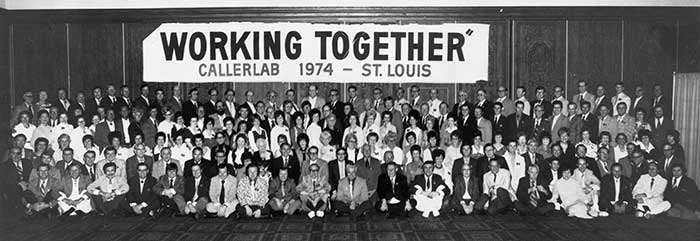
The Start of the Development of Caller Leadership
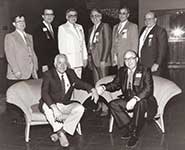
In tracing the “why” and “how” of the beginnings of an international caller-leadership organization, we need
to go back to the start of the period of contemporary western square dancing. Square dance history includes the names of prewar pioneers. All of them were performing callers. Few, if any, would have been considered “leaders”. There is, however, one exception — one name that stands out. He was a leader.
That man was Dr. Lloyd Shaw. He researched the western square dance and introduced it to his high school students and others in his community in the 1930’s. His first wide-spread recognition came in the mid ’30’s with the publication of his book Cowboy Dances and with the start of cross-country tours with his Cheyenne Mountain Dancers. All this, just a few years before America’s entry into WW2, lit the fire that would eventually propel square dancing (as a household term) into neighborhoods across the country. Shaw’s methods and philosophy would make square dancing accessible to all.
Prior to this, in rural communities across America, people enjoyed this form of dancing as an occasional activity. While there were a few itinerant callers who could handle a whole evening’s program, much of the calling was done by individuals who might know only one or two calls. There were a limited number of books with calls available but fewer than a handful explained how the calling was to be done. The dances themselves were uncomplicated when compared to today’s square dancing and, without sound amplification, the calls also were simple.
During the war…
During the war, service personnel and defense workers moved from one area to another and, if a square dance was available, anyone who knew how to call, would likely share in the program. It was during this period that many of the post-war dancers and callers had their first taste of square dancing, but the role of developing leadership would fall to Lloyd Shaw.
Shaw’s early cross-country tours and his book created great interest among school teachers and others. It wasn’t long before he began receiving requests to set up a master class and teach callers. Summer classes started in Colorado Springs a year or two before the war, but had to be suspended during the emergency. In 1946 they began again and the following year Shaw also revived his tours and the big boom of square dancing was under way. Requests to attend the week-long callers’ sessions were overwhelming. The available dancing space in the small cafetorium of the Cheyenne Mountain School would only permit 96 registrants and, taking great care to ensure that a wide variety of geographic areas were represented, each class filled rapidly.
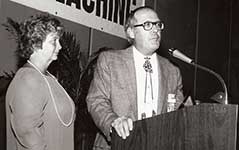
Curiosity along with a desire to collect written dance material may have been the initial reason many enrolled, but what Shaw taught went far beyond calling. Among other things, callers learned how to work with people, how to be leaders and how to ensure that the wholesome qualities of the activity would be preserved and protected. The opportunity to call for evaluation and the learning of more dances was just part of the curriculum. The “caller’s tripod”, based on the essentials of clarity, rhythm and command, was a launching pad. The importance of “dance” to an individual with movement-to-music and comfortable dance styling showed the participants that Lloyd Shaw aimed to develop leaders who could carry the torch into the second half of the 20th century.
When each class ended…
When each class ended, these “students” returned to their home areas, started classes, became leaders themselves and soon began teaching others to call. To the best of their ability they passed along what they had learned.
Shaw continued to hold twice-yearly summer master classes into the mid-1950’s, and from each class came new leaders who went out and taught dancer classes, formed callers schools, and helped create callers associations in an effort to carry on leadership training. At first, essentially those who had trained directly under Shaw trained others. Eventually those who were training new callers were several generations removed from Shaw. The cloak of leadership had been passed from a single individual to many.
With the steady growth of the square dance activity, individual areas came up with their own guidelines and some created their own codes of ethics. For a time, there was little coordination other than that collected and published by Sets In Order. This magazine, originally inspired by Lloyd Shaw, broadcast much of the Shaw philosophy, carried articles by the leaders of the day, took the lists of basics from square dance centers around the country, combined them, interpreted their styling to come up with a coordinated list and, in general, became a representative “voice of caller leadership”.
On this framework individual callers and the various areas went their own way, but there was an ever-growing urgency for callers to work more closely together for the advancement of the activity. A need for some sort of consolidated leadership became more and more apparent through the 1950’s and in August, 1960, a group of caller-leaders from several different areas met in Glenwood Springs, Colorado, to search for solutions to the escalating need of unifying terminology and styling, to create a universal moral code for callers and to offer needed leadership for the activity. Ed Gilmore, Bruce Johnson, Jim Brooks, Don Armstrong, Frank Lane, Bob Osgood, and their wives attended the several days of meetings.
In July 1964, Square Dancing Magazine (formerly Sets in Order) working with Southern California callers, Ed Gilmore, Lee Helsel, Bruce Johnson, Arnie Kronenberger, Bob Osgood, Bob Page, Bob Ruff and Bob VanAntwerp, and in conjunction with the extension division of The University of California at Los Angeles, presented a two-day on-campus caller-leadership conference utilizing a combined university and caller faculty which attracted callers from across North America. The success of this conference prompted a second session the following year.
As a result of leadership guidance in these ventures and because of the continuing growth of caller-interest, it became increasingly apparent that a close association of callers was long overdue. It was further felt that experienced, proven individuals working together could form and realize such a type of leadership.
During this time Square Dancing Magazine continued to reach out to more and more caller-leaders. Articles by top leaders disseminated on-going square dance leadership information. How-to articles were shared and callers around the world had an increasing influence on each other. Codes of ethics were published and adopted by various associations as were consolidated lists of the basics along with styling notes. Even though it reflected a true composite, all of this was done in an independent, somewhat detached manner. There still was a need for the existing leadership to work closely together.
The Start of CALLERLAB
In 1961 Sets in Order inaugurated the Square Dance Hall of Fame as a means of honoring leaders who had left their mark on the world of square dancing. Over the following decade a number of outstanding individuals were added to the list. Anyone looking at these names would recognize them as representing the ultimate composite of square dance leadership of the time. Any single one of these men might not alone be able to capture the respect of all callers, but, with all Hall of Famers working together, they presented a “body of knowledge” that a great percentage of callers could respect and follow. Their backgrounds and accomplishments formed an impressive foundation for square dance caller-leadership.
“Body of Knowledge” is the keystone of any profession. It must be unique to the field and is the basis (or bible) on which a profession is formed. The “Unique Body of Knowledge” is that which distinguishes one profession from another and therefore one activity from another.
Plans for a meeting of the members of the Hall of Fame were begun in 1970 with a founding committee made up of Lee Helsel, Arnie Kronenberger, Bob Osgood and Bob VanAntwerp. Summaries from the past ventures were studied and, following a lengthy preparation period, eight major discussion topics regarding the nature and needs of the activity were prepared as a partial charter framework for the potential new organization.
Let’s put the dance…
Let’s put the dance back into square dancing. An accepted form of standardization is vital to the growth and continuation of this activity. Caller-teacher leadership training is the responsibility of the callers and teachers. Professional standards for callers and teachers need to be established and maintained. Today’s square dancing is due for a reappraisal. The combination of the various parts of the square dance activity (squares, rounds, circle mixers, quadrilles, contras and related forms) should be encouraged. The selfish exploitation of square dancing should be vigorously discouraged. The over-organization of dancer-leader groups can pose a problem to the future progress of the activity. Invitations were mailed to fifteen members of the Square Dance Hall of Fame to attend a meeting in February 1971, as guests of The Sets in Order American Square Dance Society, to take part in an “Honors Banquet” and to discuss the “State of the Square Dance Nation”.
Eleven of the invitees were able to attend: Marshall Flippo, Ed Gilmore, Lee Helsel, Bruce Johnson, Arnie Kronenberger, Frank Lane, Joe Lewis, Bob Osgood, Bob Page, Dave Taylor and Bob VanAntwerp. When the meeting, held at the Asilomar Conference Grounds in California concluded, the group enthusiastically and unanimously signed the eight point charter and began planning for the future.
It was decided that initial growth of the organization would be on a gradual basis and that each person selected for membership would be personally invited to attend one of the meetings and, having attended, would be included as a member.
This was the start of CALLERLAB.
A second meeting…
A second meeting was held in July of that same year. Don Armstrong and Earl Johnston were included as new members at that session. The total membership had now reached thirteen.
Meeting number three was held in February, 1972, with Jerry Haag, Jerry Helt and Jim Mayo present as new members. The fourth of the Asilomar meetings was held in July, 1972, when Al Brundage and Manning Smith became members. By this time the total membership had reached eighteen. At this meeting it was decided to enlarge the group while still retaining the personal invitation method of increasing the size of membership. The February, 1973, meeting included seven new members: Stan Burdick, Cal Golden, C.O. Guest, Jack Lasry, Johnny LeClair, Melton Luttrell and Bill Peters. This session concentrated on plans for the 1974 CALLERLAB Convention.
By this time the total “founding” and “charter” membership had reached twenty-five and this body was designated the CALLERLAB Board of Governors. Jim Mayo was elected the Association’s first Chairman of the Board.
In those formative years the group named itself “CALLERLAB — the International Association of Square Dance Callers” and started DIRECTION, as its official publication. Arnie Kronenberger served the early sessions as chairman pro tem; Bob Osgood served as executive secretary. It was decided that during these early stages CALLERLAB would conduct business under the “wing” of The Sets in Order American Square Dance Society, and that CALLERLAB’s home office and staff would be provided by SIOASDS, without cost to CALLERLAB.

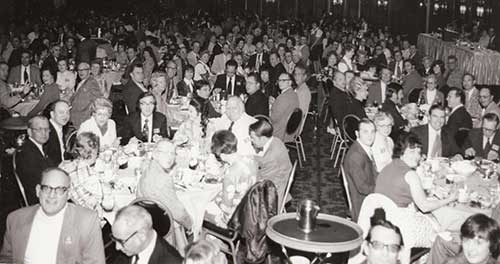
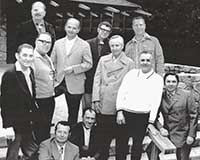 The CALLERLAB Founding Fathers had numerous discussions, a large amount of correspondence, and several meetings during the years leading to the founding of CALLERLAB. At one of the very first meetings a photo was taken of these forward thinking and dedicated callers: Marshall Flippo, Ed Gilmore, Lee Helsel, Bruce Johnson, Arnie Kronenberger, Frank Lane, Joe Lewis, Bob Osgood, Bob Page, Dave Taylor, and Bob Van Antwerp.
The CALLERLAB Founding Fathers had numerous discussions, a large amount of correspondence, and several meetings during the years leading to the founding of CALLERLAB. At one of the very first meetings a photo was taken of these forward thinking and dedicated callers: Marshall Flippo, Ed Gilmore, Lee Helsel, Bruce Johnson, Arnie Kronenberger, Frank Lane, Joe Lewis, Bob Osgood, Bob Page, Dave Taylor, and Bob Van Antwerp.